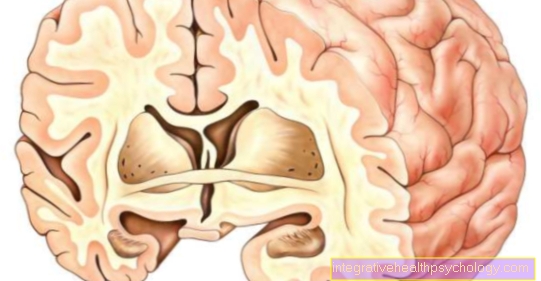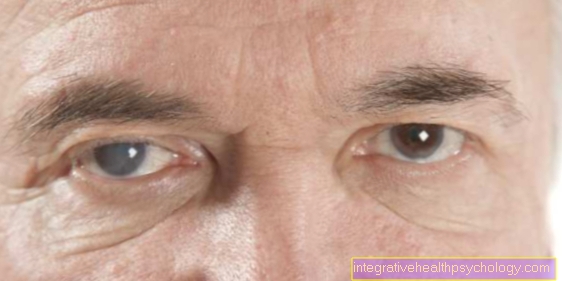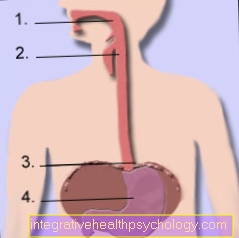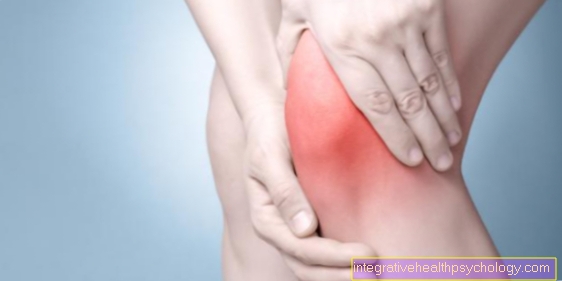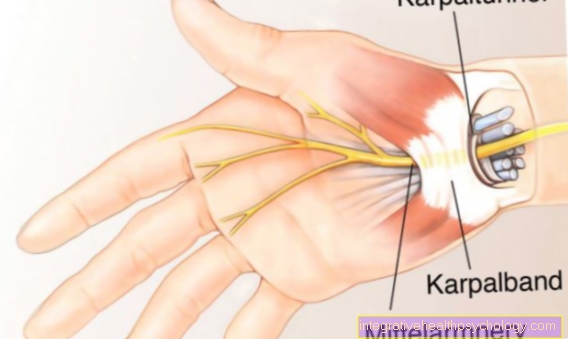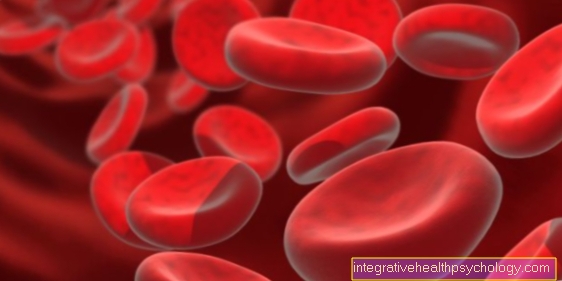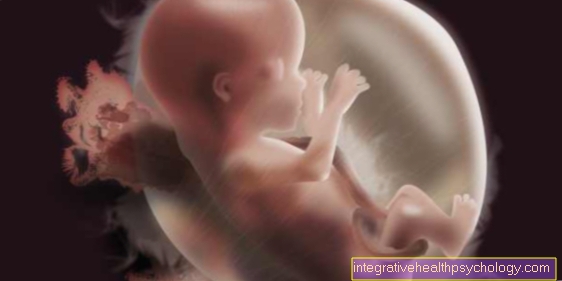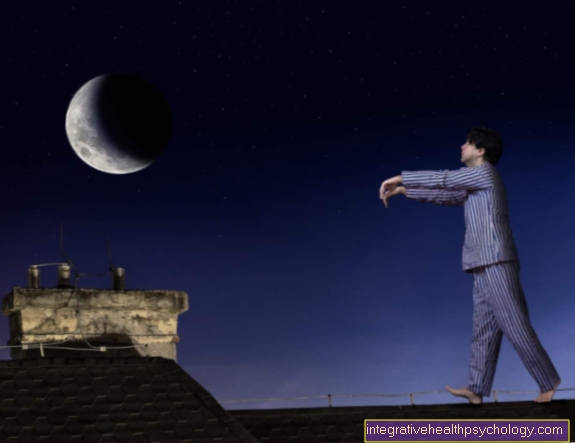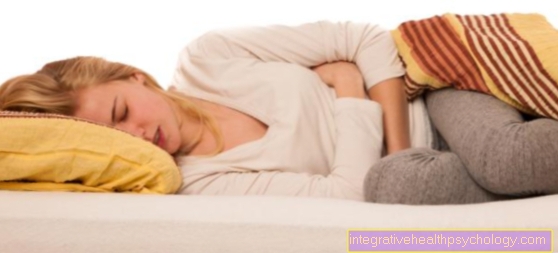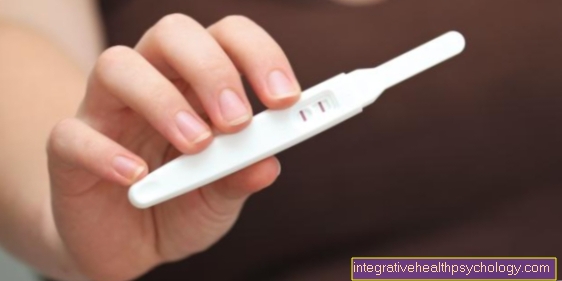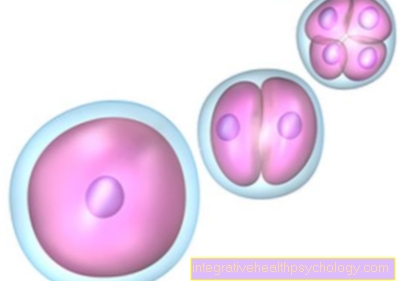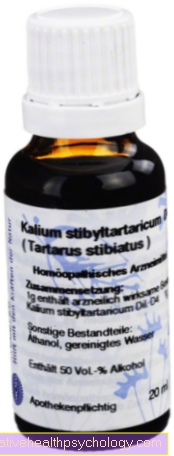chickenpox
Synonyms
Varicella infection
introduction
The so-called varicella zoster virus causes chickenpox and shingles.
If it comes to the first infection with the virus, this results in the chickenpox disease, which is an acute and highly contagious infection.
The sick have a skin rash that mainly affects the trunk, hairy head, face, neck and mucous membranes. Small, fluid-filled vesicles are particularly impressive.
The virus remains in the body for life and can be reactivated under certain conditions, in which case one speaks of zoster or shingles.

Epidemiology / Occurrence
Before vaccination against chickenpox was introduced, there were around 750,000 infections annually in Germany. The vaccination has significantly reduced the rates. Nowadays, unvaccinated children in particular get chickenpox. Every year there are around 350 cases of chickenpox requiring inpatient treatment.
Chickenpox infection is possible at any age. A particularly large number of infections occur in the age group between 1 and 4 years. Seasonally, there is an increased incidence of chickenpox in autumn and winter.
Cause / origin
The virus can be transmitted in two ways: It gets through Droplet infection as well as through direct contact with the infectious contents of the vesicles for disease transmission.
The viruses occur over the mucous membranes of the mouth, nose and throat area and over the Conjunctiva of the eyes enter the body, enter the bloodstream and finally to the skin: here, as a result of the virus infection, the formation of blisters and severe itching are caused. In addition, the virus is now excreted as an aerosol through the breath.
At the rash stage, the virus also reaches the sensitive ganglia ("nerve cell nodes") of the thorax and lumbar region; the virus remains in the ganglia lifelong.
The rash lasts for about 6 days and the last crusted blisters fall off after about 2 weeks of illness.
The infectiousness of the sick (from when sick can infect others) begins two days before the appearance of the rash and ends when the last liquid-filled blisters have dried and crusted.
How is chickenpox transmitted?
Chickenpox is transmitted by airborne droplets. Since chickenpox is very contagious, it can be transmitted from an infected person to everyone in the room without them having close contact with the infected person.
In rare cases, chickenpox can also be transmitted by smear infection. The person suffering from chickenpox is infectious 2 days before the rash begins until the last blister has healed. As long as chickenpox can be transmitted both via the air and via smear infection.
Chickenpox can also be transmitted from the mother to the unborn child, i.e. diaplacental transmission.
Symptoms
After an incubation period (time between infection and onset of the disease) of approx. 2 weeks, most sufferers have the skin rash typical of the chickenpox virus (Rash) on:
The trunk, face, arms and legs show red spots within a few hours and finally fluid-filled blisters (skin rash with blisters) that cause severe itching.
The blisters tear, crust and dry up. Eventually the crust falls off and the chickenpox usually heals without scarring.
The vesicles occur mainly on the head (face, hairy head, mucous membranes) and the trunk, arms and legs are rarely affected by a severe rash.
The children have between 50 and several hundred vesicles on the body, which are simultaneously in different stages (spots, lumps, vesicles, crusts) on the skin: The so-called starry sky pattern is present.
The sick, mostly children, are in good general condition and often do not feel sick or severely impaired, apart from the itching of the skin lesions. Only 1/3 of those affected have a fever during the course of the disease.
Read more on the topic: Chickenpox rash
Note: naming
One speaks of "chickenpox" because the viruses "go with the wind", i.e. transmitted by air, especially when coughing or sneezing.
Fever as a symptom of chickenpox
fever is a typical one Concomitant symptom of chickenpox infection.
The fever can be alleviated symptomatically. As Home remedies are the leg compresses to disposal. Medicinal can with Paracetamol or ibuprofen be treated. It is important that children are not given aspirin, as there is a risk of Reye's syndrome.
Itching as a symptom of chickenpox
Generally helps against the itching coldso that the skin can be cooled with cold towels. Also, poultices with synthetic tanning agents can help relieve itching. If the itching cannot be stopped, you can use Antihistamines be treated. These are taken orally and should lead to quick relief of the itching.
What does the early stages of chickenpox look like?
At the beginning of the disease there is a Rashthat can spread all over the skin. It goes up to that Scalp.
As a result, fluid-filled blisters form, which burst and crust over the course of the process. The vesicles appear in different stages, so that the complexion is colloquially referred to as the starry sky. After the vesicles burst, the areas crust and then heal. The rash is usually accompanied by very severe itching.
Can chickenpox appear in the mouth?
Chickenpox can also appear in the mouth. Although this is not the typical localization, all mucous membranes in the body can be affected. The chickenpox in the mouth is also represented by small red spots on which blisters form.
How contagious is chickenpox?
Chickenpox is a highly contagious disease. Because the chickenpox by droplets transmitted through the air all people who are in a room with an infected person are potentially also infected.
diagnosis
The clinical picture leads to the diagnosis: The fluid-filled vesicles, which are present in different stages at the same time (“starry sky”) are characteristic of a varicella or zoster disease.
Info: Chickenpox - Shingles
The location of the rash and the age of onset can distinguish between chickenpox and shingles.
Read more about shingles under our topic: Shingles
As a rule, virus isolations are not carried out to diagnose the disease, but this can be done using special methods such as polymerase chain reaction (PCR) or culturing the pathogen.
The detection of antibodies against the varicella virus can be the acute infection, here IgM antibodies occur, or the immunity, here one finds
IgG antibodies in the blood.
In the case of zoster, the blood sample shows an increase in IgG antibodies, which is an indication of the reactivation of the virus.
Duration
The incubation period is about two weeks and the disease is about to heal after five to seven days out. If the person does not have any other illnesses, symptomatic treatment of a chickenpox infection is usually sufficient.
This involves lowering the fever by using a leg wrap or drug therapy with paracetamol or ibuprofen. Use synthetic tanning agents or antihistamines to relieve itching.
Differential diagnoses / exclusion diseases
For infectious diseases like measles, Scarlet fever and rubella Skin rashes also occur in the form of redness, but with chickenpox alone, these form on the bottom Spots vesiclescharacteristic of varicella infection.
If the clinical picture (symptoms; characteristics of the skin symptoms) cannot be used to differentiate between the diseases mentioned, one is used Antibody examination in the blood of the diagnosis.
Vaccination against chickenpox
There is one against chickenpox vaccination. This is recommended by the STIKO (permanent vaccination commission of the Robert Koch Institute) with the combination vaccination against mumps, measles and rubella. The vaccinations are given at the age of 11-14 months or 15-23 months.
The vaccine against chickenpox is a Live vaccine. This means that the viruses are vaccinated and remain in the body. Therefore, while chickenpox infection can prevent the outbreak of chickenpox, it can nonetheless lead to one Development of the symptoms of the varicella zoster virus come after reactivation. This is the clinical picture of shingles. In vaccinated people, however, the clinical picture occurs less often and in a weakened form.
Active immunization with a live vaccine may also be considered in patients who have a weak immune system and who are suspected of having had contact with someone infected with chickenpox. This should be done no later than 5 days after exposure and can prevent the virus from breaking out. However, this is not one of the standard vaccinations.
Can you get chickenpox despite being vaccinated?
A Chickenpox infection is despite vaccination possible. This infection is known as a breakthrough infection and is defined as one infection, the after more than 43 days after vaccination was completed occurs. This is a milder infection than without vaccination, and the probability of transmission is very low.
Another phenomenon can appear right after vaccination. These are so-called vaccine varicella that can appear a few days after vaccination. This is one mild rashon which blisters can form. However, the disease is very mild and heals quickly.
Complications
Complications can arise from scratching the chickenpox sores. The opening of the skin barrier can lead to a bacterial superinfection. This is usually an infection with staphylococci or streptococci. If a skin infection occurs, antibiotics should be given.
Other possible complications include pneumonia and severe inflammation of the brain or meninges.
Complications can also occur in immunocompromised people. These patients are often found with HIV infection or chemotherapy. Antiviral therapy with acyclovir is recommended for this patient.
Other risk groups are old people or premature babies. If the mother is infected during pregnancy, the child can become infected. If the child is born with a chickenpox infection, this is a very threatening clinical picture for the newborn.
Scars after chickenpox
scar from chickenpox infection arise especially through that Scratching the blisters. The scratched skin areas can then easily become infected with bacteria, which cause inflammation. These inflamed areas of the skin then often heal with scarring.
How can I avoid scarring after chickenpox?
To counteract scarring, it is important to protect the blisters don't scratch. This is not always easy, as chickenpox is often associated with severe itching. To relieve the itching can be a Cool the affected areas with cold towels help.
In addition, drug therapy can also be used Antihistamines help to counteract the itching.
Can you get chickenpox more than once?
At a Initial infection with varicella it comes to the typical picture of chickenpox. After the symptoms have subsided, the virus remains in the body.
If the immune situation is poor, the virus can reactivate, which then leads to the symptoms of the Herpes zoster leads. In this case, the virus can be treated with acyclovir.
Chickenpox and shingles - what is the connection?
Chickenpox and shingles are based on the same pathogen. Chickenpox is the initial infection with the varicella zoster virus.
After the initial infection, the viruses persist in certain sections of the nervous system for life, so that the virus can reactivate if the immune system is poor.
Due to the localization in the ganglia, the infection then occurs along a dermatome, which means that the infection is very sharply defined. Blisters form on the affected area, in front of which only a reddening can be seen. Reactivation with herpes zoster is usually associated with severe pain.
Read more on the topic: Shingles of the eye
treatment
The chickenpox infection is treated symptomatically. Means to lower fever and relieve itching are available here. Ibuprofen and Paraceatmol can be used to lower fever. Topical creams with synthetic tanning agents or antihistamines can be used against the itching. Antiviral therapy with acyclovir can be considered in immunosuppressed people.
In the case of superinfection of the skin, antibiotics such as Cefuroxime can be used.
Read more on the topic: Therapy of chickenpox
Home remedies
As a home remedy to reduce fever, calf wraps are suitable. If this does not help, antipyretic drugs such as paracetamol and ibuprofen can be used in children.
Towels soaked in green tea can be placed on the skin to prevent itching. In addition to relieving itching, these should also have an anti-inflammatory effect. Cold towels can also help against the itching.
homeopathy
Belladonna, lemon balm extract and the mother tincture of pansy are available as homeopathic remedies for chickenpox. Most of the time, simple home remedies that relieve the symptoms will help with chickenpox. These most important symptoms are primarily relieving severe itching and lowering high fever.
Chickenpox in pregnancy
An initial infection with chickenpox during pregnancy can have consequences for the unborn child. An infection between the 13th and 20th week of pregnancy can lead to a fetal varicella syndrome come. This leads to malformations and skin changes in the newborn.
If you get an infection shortly before birth, it can cause a congenital varicella syndrome come. This can lead to severe blood poisoning in the newborn and be fatal.
Because of this risk in pregnancy, the immune status of the woman should be checked if possible before the onset of pregnancy. If no antibodies are present as a result of an infection or vaccination that has already gone through, a primary vaccination should be given with two vaccinations before the pregnancy occurs. Vaccination during pregnancy should not be carried out.
Read more on the subject at: Chickenpox in pregnancy



.jpg)


